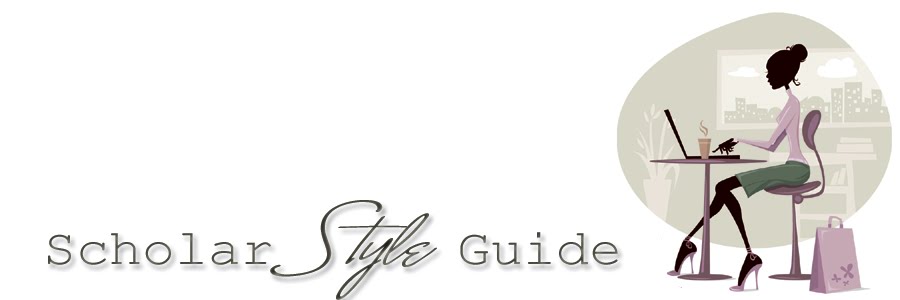Drafts:
Composition:
patterned dress (Target)
ring (grandmother's costume jewelry box)
yellow wedges (Nine West)
nail polish (OPI Tickle My France-y)
Usage:
Last month, Liz tackled the
overdressed versus underdressed debate, and she related her tendency to overdress. Today, I'd like to redefine the terms and propose some merits of underdressing.
As I see it, there are two ways to define
overdressing. First, one could define it as Liz did in her post:
overdressing means "I took this event a little too seriously." It signifies inappropriate or excessive formality. Second, one could define
overdressing like so: "I'm wearing more accessories than a Coach model." In this case,
overdressed signifies something slightly different. It means the outfit is excessively styled or overly adorned. Of course, the two definitions of overdressing may overlap in meaning, but I still maintain the distinction between them. Wearing a single cocktail dress to a backyard barbecue - definition #1 - is not the same as complicating an outfit by layering multiple garments or jewelry items - definition #2.
The latter condition would make Coco Chanel roll over in her grave. She advised women to remove at least one accessory before leaving the house, because she advocated the "less is more" rule. So I imagine she might shudder at the simultaneously belted, hatted, hosiery-ed, sock-ed, cardigan-ed, necklace-d, earring-ed, bracelet-ed women of contemporary America.
I distinguish hyper-accessorized ladies as American not only to gesture at Coco Chanel's Frenchness, but also to introduce my cause for interrogation. Lately I've stumbled upon a few essays which present the French woman's adherence to simplicity as a remedy for the American woman's supposed addiction to layering. The American woman hides behind her clothing, say these fashion critics, and she therefore over-constructs ensembles. That's why most of us are adept at executing this formula:
Cami + Cardigan + Belt + Jacket + Scarf
And why we saw so much of the Tights + Socks + Boots concoction this winter.
And why we're still seeing the Leggings + Dress + Cardigan + Belt combo now.
Alternately, the French woman relies on a single article of clothing to carry her look. The black dress, the expensive coat, or the signature bag. She does not succumb to the impulse to wear all interesting wardrobe items at once, which leaves her looking effortless and draws attention to her natural beauty rather than to her fashion sense.
Or so they say.
The argument has merit, as I see it. When I studied in Barcelona, I noticed the same trend among Spanish women. They rode the metro, walked the dog, and dined out in their finest, but they rarely looked overdone to my eyes. They did insist on minimizing their looks, though. My host mother, even, who was well into her 60s, chastised me often for wearing "too much." Her wardrobe was smaller than mine - European women invested in signature pieces, she explained, and did not
collect clothing - but to her it was more valuable. I owned a dozen department store jackets; she owned two Yves Saint Laurent coats.
To her, the expensive garments enabled simple dressing, and their ability to stand on their own imparted more value than did their
brand. Admittedly, her impulse to pare down ensembles encouraged me, because I'm not one to match and coordinate and compose my outfits, and I grew up thinking this was negligent. In fact, the closest my (wonderful! dear!) mother and I ever came to an all-out brawl was during my high school senior portrait session; she wanted me to wear the pearl necklace
and the earrings, and I insisted on wearing one or the other. I thought wearing both would make me look
overdressed, like I had over-styled. To my self-conscious 18 year old self,
over-accessorizing reeked of pretension. (Why I felt this way I cannot remember. I may have considered pearl jewelry a decidedly 'adult' thing to wear, and the reasons behind this perception merit another post.)
In the same way, style critics suggest, excessively styled (often layered) outfits convey considerable effort. And effort is not the same as thoughtfulness. Liz suggests this supposedly American tendency to excessively layer clothing might coincide with the impulse to accumulate material items. If so, the issue is one of value: how and why do we transmit value to certain articles of clothing?
Today I'm experimenting with simplification, so I appreciate a garment with a strong pattern that can sustain a look without requiring enhancement from additional pieces. Of course, the average French woman shuns patterns in favor of sophisticated, solid neutrals, so I'm departing a bit from my source of inspiration. Still, I embrace the purportedly European concept of dressing simply, and I think patterned fabrics lend themselves to it. It follows, then, that I appreciate this jersey knit dress, even though the same pattern in polyester would make me look like a veritable 1970s housewife. (A martini in hand, cat-eye makeup, and the B-52s background music would round out the aesthetic.) The black and white palette provides the option of pairing shoes and accessories of any color, the fabric is comfortable, and the belted waist offers structure. But the best part of the dress? It doesn't require a camisole, jacket, cardigan, belt, necklace, or scarf of any kind.
Prompts:
- What do you think of my proposed definitions of overdressed? Disagree, agree, or agree with edits?
- How do you diagnose the layering trend?
- What are your favorite ways to wear patterned pieces?














.JPG)






















